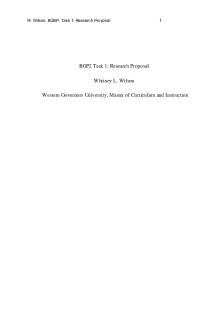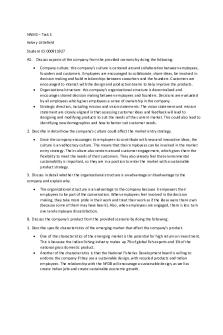c714 - Business Strategy Task 1 - passed on first try PDF

| Title | c714 - Business Strategy Task 1 - passed on first try |
|---|---|
| Author | Kelsey Littlefield |
| Course | Business Strategy |
| Institution | Western Governors University |
| Pages | 3 |
| File Size | 106.4 KB |
| File Type | |
| Total Downloads | 57 |
| Total Views | 152 |
Summary
Passed C714 task 1 for Western Governors University...
Description
NNM1 – Task 1 Kelsey Littlefield Student ID: 000911927 A1. Discuss aspects of the company from the provided scenario by doing the following: •
•
•
Company culture: this company’s culture is centered around collaboration between employees, founders and customers. Employees are encouraged to collaborate, share ideas, be involved in decision making and build relationships between coworkers and the founders. Customers are encouraged to interact with the design and production teams to help improve the products. Organizational structure: this company’s organizational structure is decentralized and encourages shared decision making between employees and founders. Decisions are evaluated by all employees which gives employees a sense of ownership in the company. Strategic direction, including mission and vision statements: The vision statement and mission statement are closely aligned in that assessing customer ideas and feedback will lead to designing and modifying products to suit the needs of the current market. This could also lead to identifying new demographics and how to better suit customer needs.
2. Describe in detail how the company’s culture could affect the market entry strategy. •
Since the company encourages its employees to contribute with new and innovative ideas, the culture is an adhocracy culture. This means that their employees can be involved in the market entry strategy. Their culture also centers around customer engagement, which gives them the flexibility to meet the needs of their customers. They also already feel that environmental sustainability is important, so they are in a position to enter the market with a sustainable product strategy.
3. Discuss in detail whether the organizational structure is an advantage or disadvantage to the company and explain why. •
The organizational structure is an advantage to the company because it empowers their employees to be part of the conversation. When employees feel involved in the decision making, they take more pride in their work and treat their work as if the ideas were there own (because some of them may have been!). Also, when employees are engaged, there is less turn over and employee dissatisfaction.
B. Discuss the company’s product from the provided scenario by doing the following: 1. Describe specific characteristics of the emerging market that affect the company’s product. •
•
One of the characteristics of the emerging market is the potential for high return on investment. This is because the Indian fishing industry makes up 7% of global fish exports and 1% of the national gross domestic product. Another of the characteristics is that the National Fisheries Development board is willing to endorse the company if they use a sustainable design, with recycled products and Indian employees. The relationship with the NFDB will encourage a sustainable design, as well as create Indian jobs and create sustainable economic growth.
2. Discuss how a product design change would meet the emerging market characteristics identified in part B1. Support this discussion with details from the scenario. •
•
The foldable boat would be new to the Indian fishing industry. This means that the company can enter the market with little to no competition, which would increase the return on investment. Since their design already meets the needs of the fisherman, very little design changes would be needed. Sourcing recycled materials locally and having workers that live in India would be a change that would meet the NFDB requirements.
a. Discuss in detail each of the stages of the design thinking process the company would undergo in the design of the product for the emerging market from part B2. •
•
•
•
•
Step 1: Empathize o The company should conduct interviews with Indian fishermen to determine their needs and wants. This will help the company gain insight about how the fishermen use the boats on a day to day basis as well as help identify how the product design can benefit the daily lives of the fishermen. Step 2: Define o The company will then take the research from the first stage and use it to define the problems the fisherman are facing. Step 3: Ideate o After the problems are identified, the team then brainstorms ideas and solutions to the defined problems. Step 4: Prototype o At this stage, the team designs scaled down versions of the boats. These are tested and examined. The team works through the designs until they have a final product. Step 5: Testing o The team tests the product to make sure it meets standards and helps solves the issues that were presented in step 1.
b. Choose three of the following aspects from the scenario, and provide a detailed discussion of their effect on the design thinking process for the product from part B2: • company culture: the company culture is one that creates an environment for creativity and innovation. Everyone is committed to the decisions made because they were involved in the decision process. • company ethics: the company is committed to making “decisions that are sustainable for customers and the environment.” Since this is already what they are committing to, the Indian standards of using recycled materials are right in line with their already established commitment. Also, since the boats are recyclable, it means that when older boats start to fail, they can recycle those into other products or to use in new boats. • organizational structure: the organizational structure goes hand in hand with the company culture. Since the organizational structure is decentralized, there is more room for creativity and innovation.
Employees are encouraged to share their ideas and be involved in all aspects of designing a new product. This allows for a multitude of ideas to be presented. 3. Discuss in detail how the company’s ethical statement from the scenario influences the market entry strategy. •
The ethical statement is “We will make decisions that are sustainable for customers and the environment.” The company will be looking for an endorsement from the NFDB, which should be attainable with sourcing local, recycled materials. Preserving the ecosystem is an important aspect as well. India and the company are looking for improving the fisherman’s experience by providing a foldable boat that is portable, easy to carry and affordable.
References: Hanko Hackberry Group. (n.d.). Fisheries industry. Retrieved from http://investinindia.com/industry/fisheries/fisheries-industry
National Fisheries Development Board. (n.d.). About Indian fisheries. Retrieved from http://nfdb.gov.in/about-indian-fisheries.htm...
Similar Free PDFs

Task 1 C228 WGU PASSED first TRy
- 13 Pages

DO94 Task 1 Pass on First Try
- 7 Pages

First TRY
- 8 Pages

TAT2 Task 1: Passed
- 14 Pages

C227 Task 1 - Passed Task
- 22 Pages

D082 Task 1- PASSED
- 2 Pages
Popular Institutions
- Tinajero National High School - Annex
- Politeknik Caltex Riau
- Yokohama City University
- SGT University
- University of Al-Qadisiyah
- Divine Word College of Vigan
- Techniek College Rotterdam
- Universidade de Santiago
- Universiti Teknologi MARA Cawangan Johor Kampus Pasir Gudang
- Poltekkes Kemenkes Yogyakarta
- Baguio City National High School
- Colegio san marcos
- preparatoria uno
- Centro de Bachillerato Tecnológico Industrial y de Servicios No. 107
- Dalian Maritime University
- Quang Trung Secondary School
- Colegio Tecnológico en Informática
- Corporación Regional de Educación Superior
- Grupo CEDVA
- Dar Al Uloom University
- Centro de Estudios Preuniversitarios de la Universidad Nacional de Ingeniería
- 上智大学
- Aakash International School, Nuna Majara
- San Felipe Neri Catholic School
- Kang Chiao International School - New Taipei City
- Misamis Occidental National High School
- Institución Educativa Escuela Normal Juan Ladrilleros
- Kolehiyo ng Pantukan
- Batanes State College
- Instituto Continental
- Sekolah Menengah Kejuruan Kesehatan Kaltara (Tarakan)
- Colegio de La Inmaculada Concepcion - Cebu









